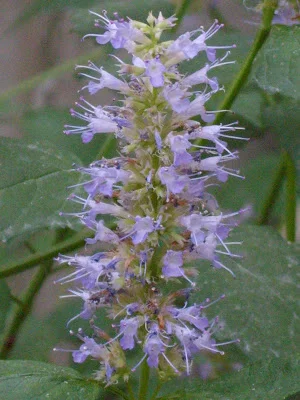Purple Giant Hyssop, Wrinkled Giant Hyssop, Korean Mint, Blue Licorice, huò xiāng (藿香), bangsnnip (방아잎), Patchouli herb--whatever regional name is chosen, they all refer to the same plant: Agastache rugosa (Fisch. & C.A.Mey.) Kuntze. For purposes of this post, the two most abundant names I found were (Purple) Giant Hyssop and Korean Mint, hence the top-title billing. However, the other names are equally notable and have thus been included. In the rest of the entry, the plant will be referred to by its Latin name.
This species, like many Agastache, does well in warm, humid conditions and enjoys full sun and warm, moist and well-drained soil. The perennial can grow to between 1 and 4 feet tall, depending on conditions, and 1 to 3 feet wide, though usually around 18 in. The flowers are hermaphroditic and are pollinated by bees, butterflies, and hummingbirds.
Known for its culinary and medicinal properties, A. rugosa has often been used as an anti-fungal and is considered one of the 50 fundamental herbs in traditional Chinese medicine (TCM). A Korean native, this plant has been introduced to the American southwest and grows there in containers quite easily, displaying blue-purple flowers, midsummer to early autumn. It is used to treat abdominal pain and as a source of essential oils.
Leaves can be eaten plain, as part of a salad, or added to a cooked dish for a strong anise-like aroma and flavor. They can also be steeped as a tea. In TCM, it (Korean mint) is known as a "warming herb" and is used to boost digestion and increase energy. The leaves and stems are used in internal medicine to aid the digestive system and improve appetite, relieving bloating, nausea, and vomiting in addition to chest congestion, diarrhea, and headaches. The leaves have also been used to relieve angina pain and morning sickness. A. rugosa is also used as a folk remedy for cancer and has been shown to have anti-cancer properties when studied. This is largely due to the plant's inherent antifungal, antibacterial, "aromatic, carminative, diaphoretic, febrifuge and stomachic" (pfaf.org), properties.
Sources:
1. http://www.efloras.org/florataxon.aspx?flora_id=2&taxon_id=200019465
2. http://www.finegardening.com/wrinkled-giant-hyssop-korean-hyssop-purple-giant-hyssop-agastache-rugosa
3. https://upload.wikimedia.org/wikipedia/commons/9/9d/Agastache_rugosa_03.JPG (photo)
4. http://www.pfaf.org/user/Plant.aspx?LatinName=Agastache+rugosa
5. A Barefoot Doctors Manual.
6. Yeung. Him-Che. Handbook of Chinese Herbs and Formulas.
7. Duke. J. A. and Ayensu. E. S. Medicinal Plants of China
8. Bown. D. Encyclopaedia of Herbs and their Uses
9. Medicinal Plants in the Republic of Korea
10. Chevallier. A. The Encyclopedia of Medicinal Plants
11. Foster. S. & Duke. J. A. A Field Guide to Medicinal Plants. Eastern and Central N. America.

